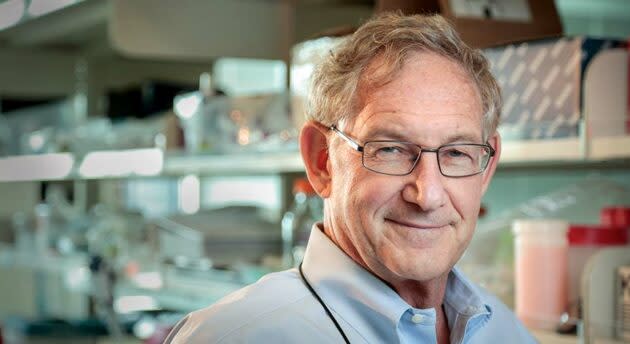Vaccine veterans preview milestones on the long road to the end of the pandemic

A public-private partnership called Operation Warp Speed is aiming to get multiple vaccines approved by the end of the year to protect against COVID-19 — but two veterans of the vaccine development process say there’s a long road ahead, with no wormholes in sight to reduce the travel time.
Anthony Fauci, director of the National Institute of Allergy and Infectious Diseases, said this week that there should be a “couple hundred million doses” of vaccines available by the start of next year.
That’s an ambitious timetable, according to John Mascola, head of NIAID’s Vaccine Research Center; and Larry Corey, a virologist at Seattle’s Fred Hutchinson Cancer Research Center.
“I don’t think either John or I are particularly happy with Tony telling everybody that it’s here by January, but if everything goes well, that’s definitely possible,” Corey said today during a webcast presented by Fred Hutch.
Operation Warp Speed is fast-tracking vaccine development efforts at five companies, representing three different approaches: Moderna and Pfizer are working on RNA-based vaccines, Johnson & Johnson and an Oxford-AstraZeneca team are using genetically modified cold viruses, and Merck is taking advantage of viral vector technology.
Moderna and AstraZeneca are in the lead, with Phase 2 clinical trials underway and Phase 3 within sight. Pfizer, meanwhile, is in the midst of Phase 1 trials.
Some researchers have complained that Operation Warp Speed is being too quick to limit the options for COVID-19 vaccines. But Mascola emphasized that the five companies won’t be the only ones getting federal support. He pointed out that that the federal government’s Biomedical Advanced Research and Development Authority, or BARDA, is providing $30 million for Sanofi’s recombinant-DNA vaccine.
“We’re working with them, and there may be others, too,” Mascola said.
Corey and Mascola have been leading the fight against infectious diseases for decades. Both have focused on HIV prevention in the past, and that background is coming in handy for dealing with the coronavirus pandemic.
The HIV Vaccine Trials Network, which is headquartered at Fred Hutch with Corey as its director, has stepped up to assist with coronavirus studies. The network’s first COVID-19 clinical trial focuses on identifying antibodies that can be used to diagnose and treat the disease.
Other Fred Hutch researchers report extracting an antibody from the blood of a recovered COVID-19 patient, and then using that antibody to block coronavirus proteins. So far, the antibody’s activity has been tracked only in the lab. But the study, published today in the journal Immunity, may open a new avenue for treatment.
Such treatments should work hand-in-glove with vaccine development programs, to ensure that even if a vaccine doesn’t work, there’ll be ways to help the participants in clinical trials fight off the infection.

Even if multiple vaccines win approval, manufacturing and distributing those vaccines to billions of people around the world will be a huge challenge, Corey said.
“Unfortunately, for many vaccines, that has taken years and years and years,” he said. “Part of the system that has to be developed is not just to evaluate the vaccine, but essentially shorten the time to manufacturing and definitely shorten the time to distribution.”
It’s way too early to determine how the vaccination process will work, or whether people will have to get a yearly shot, as is the case with flu vaccines. “We don’t know how long that protection will last,” Mascola said.
Will enough people be willing to get a shot, particularly during the big clinical trials?
“The trials we’re doing are very large, 30,000 persons per trial, and they’re overpowered so we can get a rapid answer,” Corey said.
Getting that many people to participate will require building up an extraordinary amount of trust.
“One of the reasons we propose this public-private partnership is to take the whole thing out in the open, to recognize that it’s the NIH [National Institutes of Health] and it’s taxpayer dollars that are actually being used for the clinical trial,” Corey said. “There is no commercialism in essentially this aspect of defining the safety and efficacy. We’re going to do it in an open and transparent way.”
Even if researchers develop safe and effective vaccines, the virus isn’t likely to disappear completely.
“We still see persistence and micro-epidemics throughout the country, and I think that that is going to occur,” Corey said. “Our job is to do the vaccination campaigns where the virus is.”
So what will the post-pandemic world look like at the end of 2021?
Coronavirus Live Updates: The latest COVID-19 developments in Seattle and the world of tech
“I think there’s a reasonably good chance we’ll have effective therapeutics,” Mascola said. “We have small-molecule drugs, we have antibodies. Even if one of them works, or some of them work, just think of what a huge difference it would mean to know that if you get sick, there’s an intervention that’s going to keep you out of the intensive care unit.”
There’ll also be vaccines. “The challenge will be, how well distributed are they? Are they available to everybody?” Mascola said.
Corey put more of a personal spin on his post-pandemic prediction.
“I’m planning to go skiing in December of 2021, which means, A. we’re going to have vaccines that are effective; B. I’m going to be vaccinated; and C. there are going to be monoclonal antibodies also,” he said. “I think the only way out of the epidemic is through science, and I think we are beginning to see what the scientific community and the scientific establishment can actually do in a rapid period of time.”

